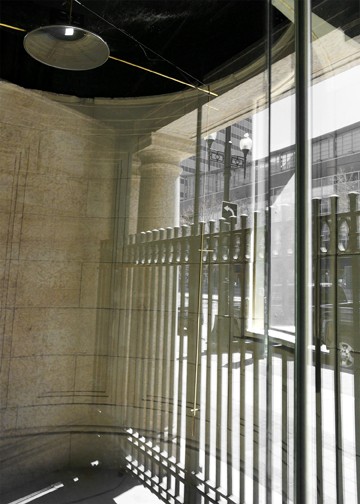Analoging the Digital
Kyle Janzen and Chris Burke have removed all the vowels from their patronyms to come up with the name of their collaborative partnership. JNZNBRK has been making moving images and sculpture and designing site-specific installations since student days at the University of Manitoba School of Architecture. They produce what they call instruments, “things for generating light and sound, or listening to light, or making sound from light.” Their most recent collaboration occupies the DOT Gallery space in the Mitchell-Copp façade at 315 Portage Avenue in Winnipeg, where it will be installed until May 31.
Their tendency is to take one sense and elaborate it through another. In 2014–15 they made Hearing Eyes; this recent piece at the DOT Gallery could accurately be named Seeing Ears. “We like finding something very physical and then augmenting it,” says Burke. “If you can see it, what does it sound like, and if you can hear it, then what does it look like?”

JNZNBRK, Instrument 002, brass armature with embedded light sensor.
Instrument 002 plays within that sensory terrain. The piece is a simple kinetic construction made from brass with wiring inside. Every minute a slow-moving motor rotates in the centre of the space. The arm has three embedded sensors, which read different zones in the space and which are tuned to different frequencies—low, medium and high. Each of the sensors includes a photocell, and they change the voltage as the arm rotates. The light drives the intensity of the tones; the more sunlight you get, the fuller the sound. The space is heard because of the light contained within it. Burke thinks of what we hear as “little compositions.” An overcast, mellow day will be followed by opposite weather conditions, and that dramatic change registers in a different way. “On a bright, sunny day the sound can be almost overwhelming,” Burke says. “When that happens, the space can be howling.”

Drawing of Instrument 002 within gallery.
The pair works the line where the digital and the analog intersect. Janzen welcomes the resistance and friction that come with the analog because they help shape the structure of their pieces. Despite the fact that digital technology makes it possible to do anything you want, since all that is required is rearranging the numerical data set, Janzen and Burke are attracted to the limitations of the analog. “We could make something on the computer and that’s what it was. It seemed kind of empty,” Janzen says. “So it’s nice to have a relationship to space and materials, which goes back to what we do as architects.” Burke agrees: “If you stick with the analog, there is always pushback and I think you need the pushback. Besides, it became a lot more playful when we went analog.”
The sense of play in which they are engaged brings with it a particular look. “From the beginning of our collaboration we were interested in how things have their own imperfections and inherent qualities. We don’t want to hide what we’re doing. For us the honesty of the piece is to expose what’s happening,” Janzen says. “We give it just enough behaviour to start it and then we stand back and watch what it’s going to do on its own,” Burke adds. “The thing gets to be honest with itself, too.” ❚

Dot Gallery Façade, Winnipeg. Images courtesy of the artist.

View of Instrument 002, from entry.

